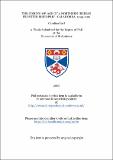Files in this item
The coming-of-age of a northern Iberian frontier bishopric : Calahorra, 1045-1190
Item metadata
| dc.contributor.advisor | Pascua, Esther | |
| dc.contributor.author | Carl, Carolina | |
| dc.coverage.spatial | 352 p. | en_US |
| dc.date.accessioned | 2018-05-30T12:25:59Z | |
| dc.date.available | 2018-05-30T12:25:59Z | |
| dc.date.issued | 2005 | |
| dc.identifier.uri | https://hdl.handle.net/10023/13616 | |
| dc.description.abstract | The northern Iberian Bishopric of Calahorra was re-founded in 1045 by Garcia 111 of Navarre. Between that date and the death of its eighth post-restoration bishop in 1190 all or part of its diocesan territory changed hands seven times between the Kingdoms of Navarre, Leon-Castile/Castile, and Aragon, as they competed over the riojan frontier- zone on which it was located. The position of the diocese on such a volatile secular frontier had consistently profound, but also steadily changing, effects on its political and institutional development. In the initial phase of Calahorra's restoration, its bishop was enormously empowered by his central role in the consolidation of Navarre's southern and western frontiers, but was held back from establishing a centralized diocesan administration by the insecurities inherent in the borderland condition of his see. Following a change of political regime in the Rioja in 1076, the bishopric suffered the severe consequences of its total identification with a defeated secular power when its embryonic diocesan structures were comprehensively dismantled and its bishops subjected to a dominant and hostile crown that effectively undermined their diocesan authority. The debilitation of royal authority in the Rioja and the region's political marginalization between 1109 and 1134 provided the context for the emergence of the see's independent political stance and its notably autonomous and rapid development of a strong cathedral. When Leonese-Castilian regional dominance was forcefully reasserted between 1134 and 1157, the Bishops of Calahorra were able to put the forceful currents of canonical reform that emanated from an increasingly comprehensive and emphatically territorial secular ecclesiastical hierarchy to use in combining their centrality to the north-eastern border politics of the Crown of Leon-Castile with the independent pursuit of a specifically diocesan agenda. When Castile ceased serving Calahorra's territorial interests towards the end of the twelfth century, the see used the political leverage it gained by its inclusion in the Aragonese Metropolitanate of Tarragona to distance itself from Castilian politics, thus revealing its maturity as a frontier power in its own right. | en_US |
| dc.language.iso | en | en_US |
| dc.publisher | University of St Andrews | |
| dc.subject.lcc | BX1587.C35C2 | |
| dc.subject.lcsh | Catholic Church.--Diocese of Calahorra y La Calzada--History | en |
| dc.subject.lcsh | Calahorra (Spain)--Church history--10th century | en |
| dc.subject.lcsh | Calahorra (Spain)--Church history--11th century | en |
| dc.subject.lcsh | Calahorra (Spain)--History | en |
| dc.subject.lcsh | Navarre (Kingdom)--History--To 1515 | en |
| dc.subject.lcsh | Leon (Kingdom)--History | en |
| dc.subject.lcsh | Aragon (Kingdom)--History | en |
| dc.title | The coming-of-age of a northern Iberian frontier bishopric : Calahorra, 1045-1190 | en_US |
| dc.type | Thesis | en_US |
| dc.type.qualificationlevel | Doctoral | en_US |
| dc.type.qualificationname | PhD Doctor of Philosophy | en_US |
| dc.publisher.institution | The University of St Andrews | en_US |
This item appears in the following Collection(s)
Items in the St Andrews Research Repository are protected by copyright, with all rights reserved, unless otherwise indicated.

